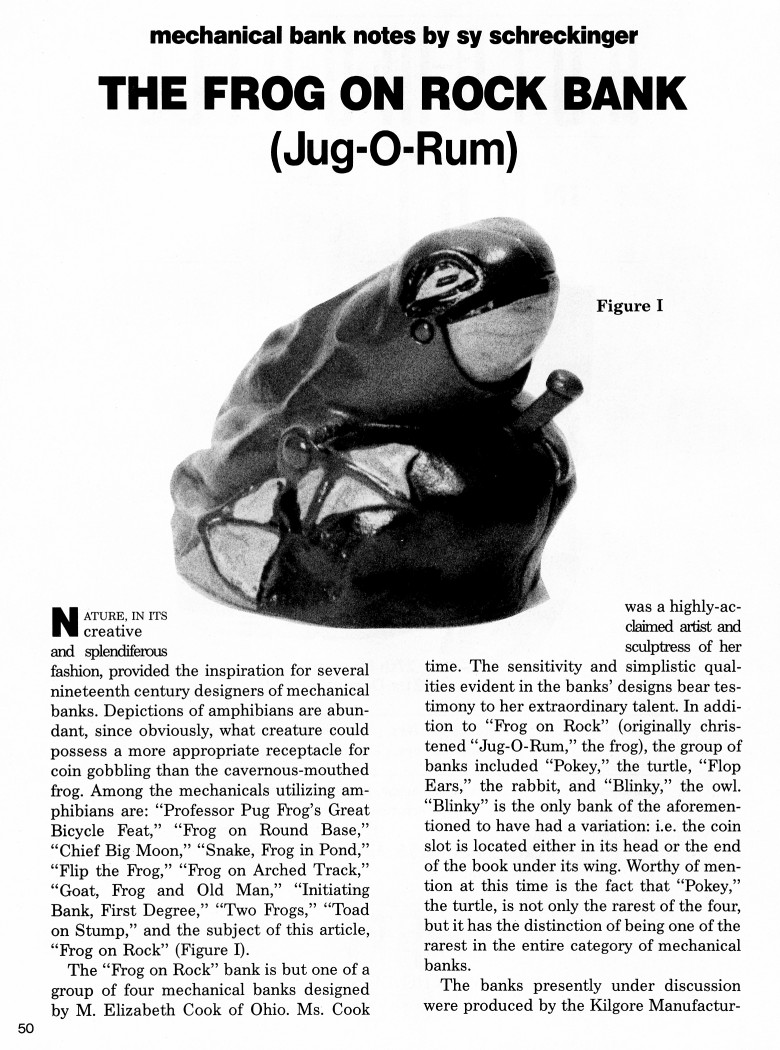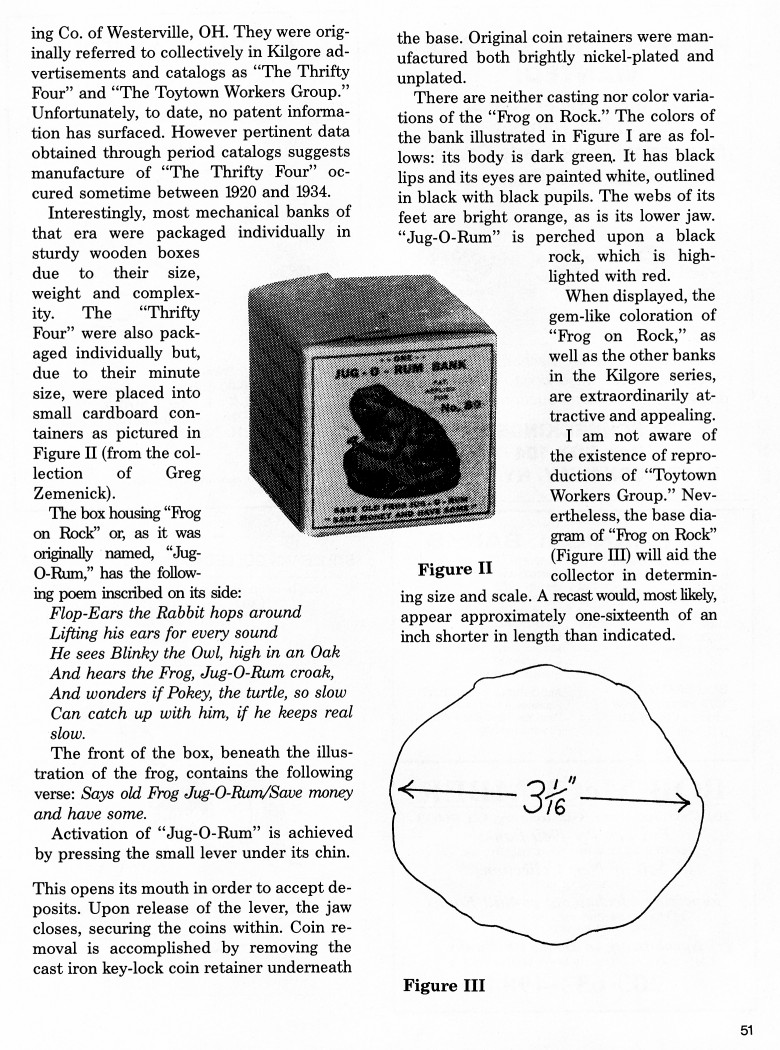|
The Frog on Rock Bank
(Jug-O-Rum)
by Sy Schreckinger – ANTIQUE TOY WORLD Magazine – December, 1991
Nature in its creative and splendiferous
fashion, provided the inspiration for several nineteenth century designers
of mechanical banks. Depictions of amphibians are abundant, since
obviously, what creature could possess a more appropriate receptacle for
coin gobbling than the cavernous-mouthed frog. Among the mechanicals
utilizing amphibians are: "Professor Pug Frog's Great Bicycle Feat," "Frog
on Round Base," "Chief Big Moon," "Snake, Frog in Pond," "Flip the Frog,"
"Frog on Arched Track," "Goat, Frog and Old Man," "Initiating Bank, First
Degree," "Two Frogs," "Toad on Stump," and the subject of this article,
"Frog on Rock" (Figure I).
The "Frog on Rock" bank is but one of a group of four mechanical
banks designed by M. Elizabeth Cook of Ohio. Ms. Cook was a
highly-acclaimed artist and sculptress of her time. The sensitivity and
simplistic qualities evident in the banks' designs bear testimony to her
extraordinary talent. In addition to "Frog on Rock" (originally christened
"Jug-O-Rum," the frog), the group of banks included "Pokey," the turtle,
"Flop Ears," the rabbit, and "Blinky," the owl. "Blinky" is the only bank
of the aforementioned to have had a variation: i.e. the coin slot is
located either in its head or the end of the book under its wing. Worthy
of mention at this time is the fact that "Pokey," the turtle, is not only
the rarest of the four, but it has the distinction of being one of the
rarest in the entire category of mechanical banks.
The banks presently under discussion were produced by the Kilgore
Manufacturing Co. of Westerville, OH. They were originally referred to
collectively in Kilgore advertisements and catalogs as "The Thrifty Four"
and "The Toytown Workers Group." Unfortunately, to date, no patent
information has surfaced. However pertinent data obtained through period
catalogs suggests manufacture of "The Thrifty Four" occurred sometime
between 1920 and 1934.
Interestingly, most mechanical banks of that era were packaged
individually in sturdy wooden boxes due to their size, weight and
complexity. The "Thrifty Four" were also packaged individually but, due to
their minute size, were placed into small cardboard containers as pictured
in Figure II (from the collection of Greg Zemenick).
The box housing "Frog on Rock" or, as it was originally named,
"Jug‑O-Rum," has the following poem inscribed on its side:
Flop-Ears the Rabbit hops around
Lifting his ears for every sound
He sees Blinky the Owl, high in an Oak
And hears the Frog, Jug-O-Rum croak,
And wonders if Pokey, the turtle, so slow
Can catch up with him, if he keeps real slow.
The front of the box, beneath the illustration of the frog, contains
the following verse: Says old Frog Jug-O-Run/Save money and have some.
Activation of "Jug-O-Rum" is achieved by pressing the small lever
under its chin. This opens its mouth in order to accept deposits. Upon
release of the lever, the jaw closes, securing the coins within. Coin
removal is accomplished by removing the cast iron key-lock coin retainer
underneath the base. Original coin retainers were manufactured both
brightly nickel-plated and unplated.
There are neither casting nor color variations of the "Frog on Rock."
The colors of the bank illustrated in Figure I are as follows: its body is
dark green. It has black lips and its eyes are painted white, outlined in
black with black pupils. The webs of its feet are bright orange, as is its
lower jaw. "Jug-O-Rum" is perched upon a black rock, which is highlighted
with red.
When displayed, the gem-like coloration of "Frog on Rock," as well as
the other banks in the Kilgore series, are extraordinarily attractive and
appealing.
I am not aware of the existence of reproductions of "Toytown Workers
Group." Nevertheless, the base diagram of "Frog on Rock" (Figure III)
will aid the collector in determining size and scale. A recast would, most
likely, appear approximately one-sixteenth of an inch shorter in length
than indicated.
|


